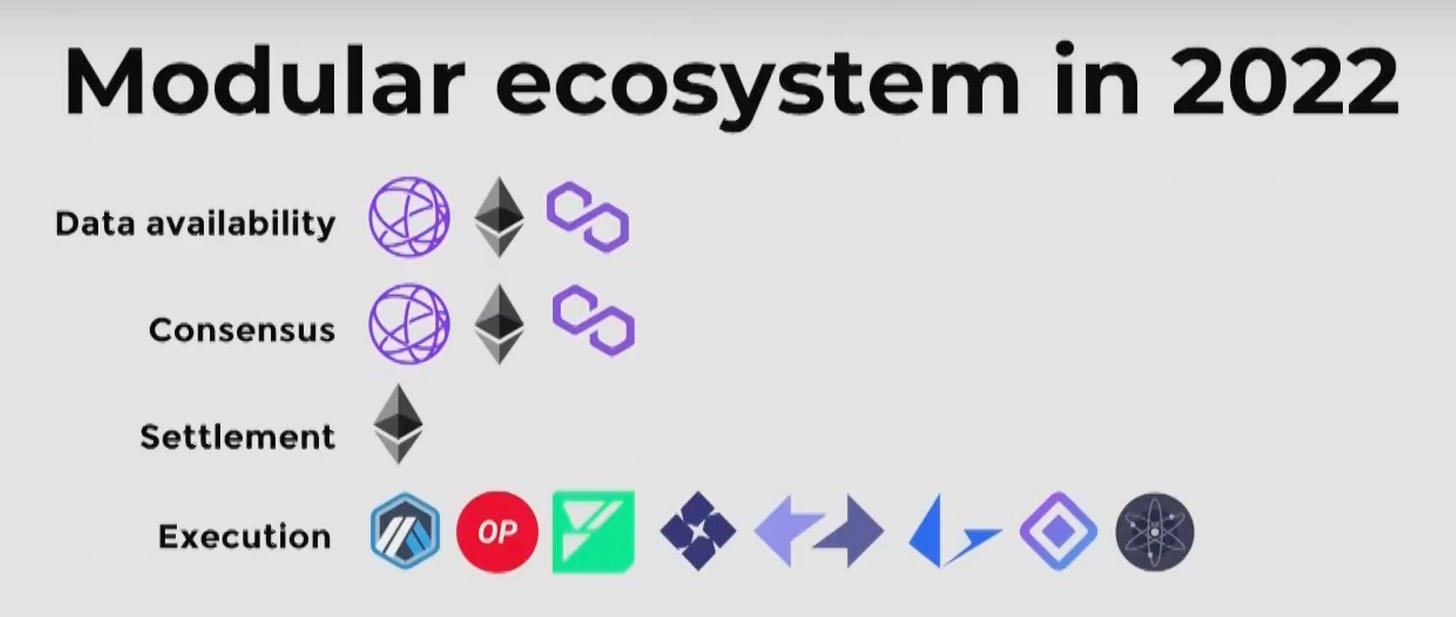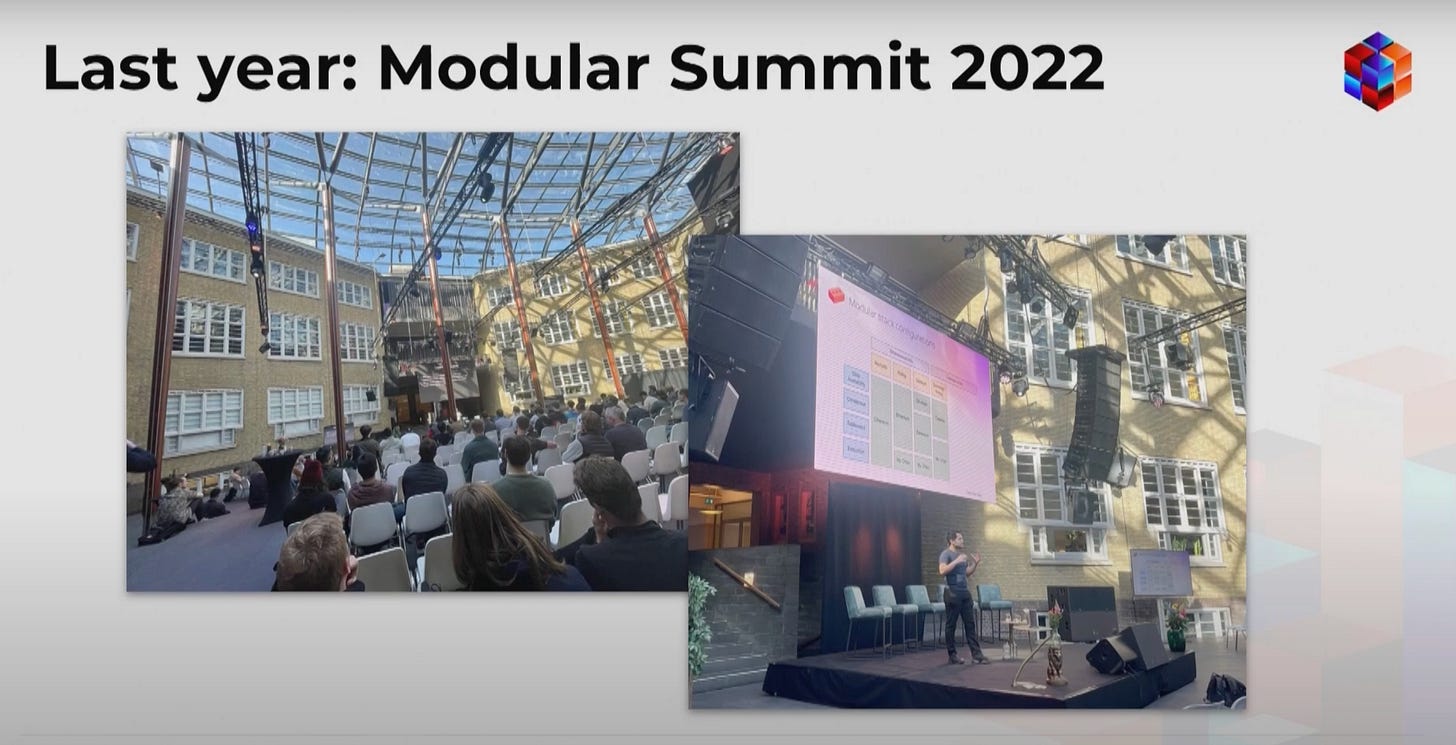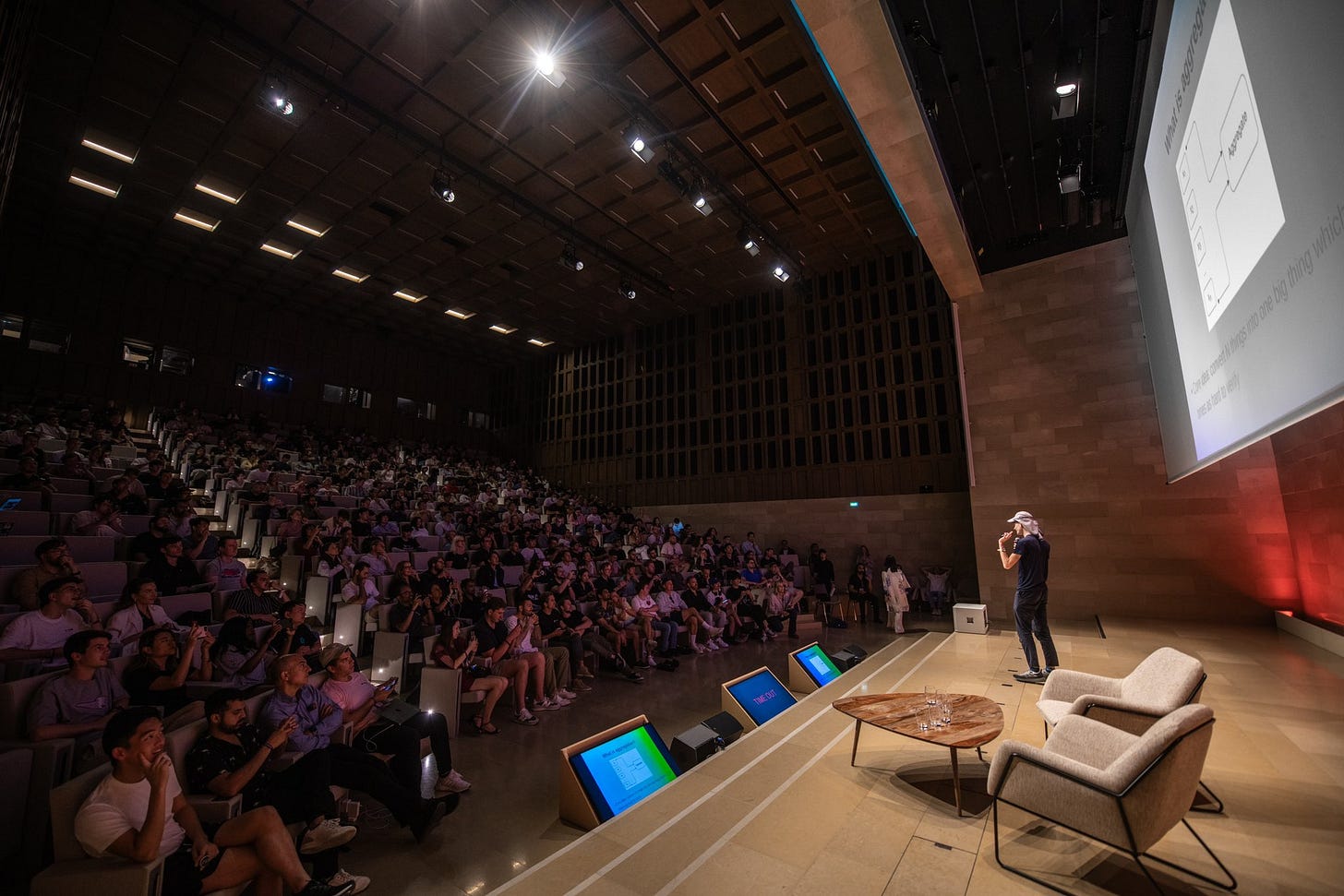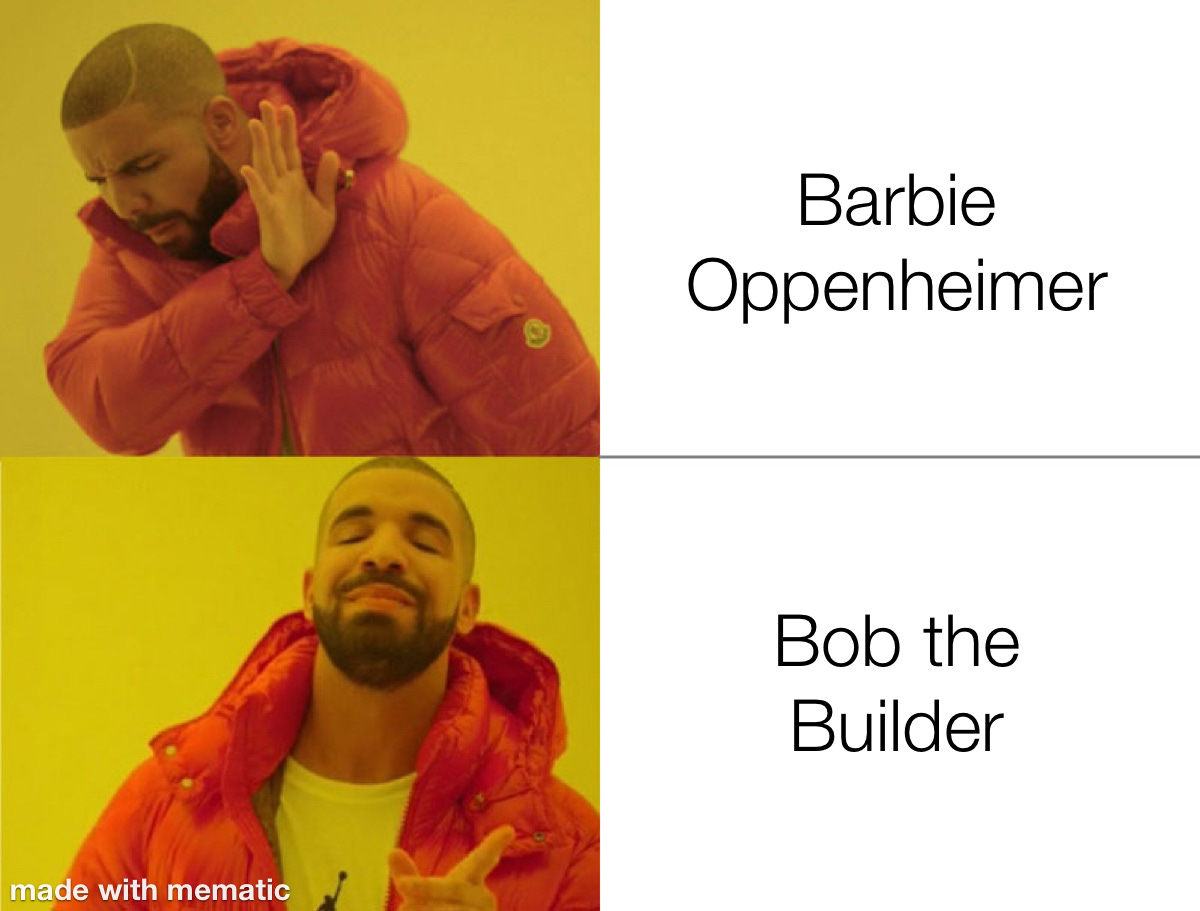Modular Summit 2023 Recap
In this post we’ll run through highlights from the Modular Summit event - interesting announcements, presentations and other 💎s that spoke to us.
Modular Summit 2023, hosted by Celestia and Maven11 in Paris this past week, brought modularists from across the globe together to discuss the future of - you guessed it - modular blockchains!
For starters, the modular ecosystem has grown substantially since last year. Many categories have emerged in the modular stack, from new protocol layers to supporting tools and infrastructure providers.
We saw tons of new projects take the stage for the first time, including infrastructure providers like Modular Cloud, new sequencer solutions like Astria, new rollup frameworks and RaaS solutions like Rollkit, Sovereign, Eclipse, and Caldera, as well as cross-chain interoperability layers like Axelar, and Hyperlane.
The Modular Experience
Dino here 👋
As you can see, the modular ecosystem has really grown. Below we’ll dive into a bunch of these projects, but first, we’d be remiss to not comment on the more astonishing year-over-year growth - brainpower and vibes. Not a joke! I had the honor of being apart of this year’s Modular Summit and was simply blown away.
Most conferences have presentations and panels, but from my experience any given one is hit or miss (even EthCC). Modular Summit was a steady stream of mind-benders. I didn’t want to leave my seat, and good thing I mostly didn’t, because seats were hard to come by.
Ok, I know what you’re thinking. “Dino I can find these talks on Celestia’s YouTube channel”. You certainly can and I encourage you to watch (or rewatch like me) every one of them. But this isn’t the full story.
The most memorable part of Modular Summit was by far the sense of community. There’s a reason the talks were so good. The modular philosophy has managed to capture the hearts and minds of the brightest in crypto, across all different blockchain ecosystems, which are historically hostile towards one other (nothing illustrated it better than the endgame panel). This was not only clear in the talks but in every interaction I had - and I know others had similar experiences.
What’s become clear is that modularity is more than a way to architect scalable blockchains. It’s a movement that elegantly sits at the intersection of decentralization, sovereignty, and a truly positive-sum mindset.
On CT you can hear “modularism > maximalism” but at Modular Summit you could feel it.
Ok, enjoy the recap, and see you next year 🙃
Presentation Highlights
Hey everyone, Pedro here 👋
This second-year event gave us the opportunity to listen to several speakers from teams across the modular stack. From individual presentations by teams like World Engine and Berachain, to workshops, and panel discussions with DA layers, RaaS providers, shared sequencers, and so much more. While we won’t be able to cover every single presentation here today, hopefully, we’ll be able to set you off on a good starting ground.
That said, be sure to keep an eye on our Twitter account, as we’ll be putting up a pole tomorrow to let the community decide which presentations you want us to recap in detail.
Let’s begin 👇
State of the Union Speech
The event started with the “Modular State of the Union” presentation by Mustafa, co-founder of Celestia.
Mustafa touched on:
A general overview of modular blockchains: So, looking at the different layers of the stack, as well as the benefits of modularity, which includes scalability & flexibility.
Progress on the development of the modular stack: I mean, did you see the 2022 Modular ecosystem vs. 2023’s ecosystem?
Open problems: such as better UX for bridging, better proving systems, better privacy, and more.
& the destination: we need to get to a point where every user is treated as a first-class citizen of the network.
For a more detailed summary of this talk, you can check out @Cumulo_pro’s breaks down here.
Data Availability
The Data Availability (DA) Panel
If you’ve been following us for a while now, you’ll know that DA layers kind of started this whole modular journey - shoutout Celestia. That said, there have been other teams that started building their own DA solution over the past year, such as Avail (prev. Polygon Avail), and Eigen DA.
During the summit, Bartek Kiepuszewski, from L2Beat, hosted a panel discussion with some of these DA chads, including Mustafa, co-founder of Celestia, Anurag, co-founder of Avail, & Scroll’s own Toghrul Maharramov, who was representing Ethereum.
The conversation largely revolved around the question of whether or not Ethereum should care about these new DA solutions, considering proto-danksharding is coming to the network (proto-danksharding is expected to lower data costs for Ethereum).
Here are some quick notes from the discussion:
TLDR: there is room for several DA solutions, and ultimately, it’ll be up to the developers themselves to decide whether or not their application requires strong security guarantees (DA on Ethereum), or if they’re willing to give some of this security up in return for lower costs for its users
A game with no underlying monetary value may not need the highest level of security, whereas a DeFi application with billions of dollars in TVL may need the highest grade of security. Again, this is all as it relates to Ethereum L2s.
Some 🌶 Eigen Layer takes were also mentioned
There were several other DA related discussions throughout the event, including:
“Avail architecture & its use cases”, by Anurag Arjun, Avail co-founder
“Light nodes are not just a meme” by Nick White, Celestia co-founder
“DA as a broadband” by Alex Evans, partner at Bain Capital
“Celestia architecture: the present & a glimpse into the future” by Celestia co-founder & CTO Ismail Khoffi
“Shielded DA on Celestia” by Anoma co-founder Adrian Brink
RaaS & Rollup Frameworks
Over the past year, we have seen multiple teams deploy their own rollups. This is largely thanks to projects like Caldera, Dymension, Eclipse, Stackr, and several others that are helping make rollup deployment much simpler for developers.
Essentially, these solutions provide the components that developers can pick & choose from in order to build their own custom rollup (execution environment). The difference between a RaaS and a rollup framework solution is largely whether you want your rollup ‘hosted’ (operated by someone else) or not.
This year’s Modular Summit gave us the opportunity to listen to several of these solutions, allowing us to hear about what sets these solutions apart from one another, their individual look on the overall landscape, & much more.
RaaS Panel
Tracy Wang from CoinDesk moderated a panel discussion with the founders of Caldera, AltLayer, Eclipse, and Stackr, which was the sole rollup framework solution from this panel. Here are some notes from this discussion:
The conversation started off by touching on how RaaS can be thought of similarly to “the AWS of web3” - you choose some parameters, click a few buttons, and you have your own rollup. Whereas with Stackr, along with other rollup framework solutions, developers get more ownership over their rollup, but rather than just pressing a button to deploy, you put the (already built) components together yourself manually.
The panel also touched on the fact that “side chains as a service” could have been done years ago, however, the reason teams didn’t go in this direction was because of the economic cost associated with launching your own PoS chain. You not only need to have millions of dollars in stake securing your rollup, but you also need to bootstrap a decentralized enough validator set. With rollups, you just outsource security from a base layer.
Following this, the panel touched on several other topics, including (1) why developers should want to use their specific solution (looking at the benefits of each), (2) potential revenue sources for these types of solutions - I thought AltLayer’s tiered pricing and pay-as-you-go models seemed interesting, and (3) some of the pain points developers are facing today when launching their own rollup, such as interoperability, liquidity fragmentation, and latency (users want 100MS transactions, not 1-2 second ones).
Throughout the event, there were several other presentations done by RaaS and Rollup Framework solutions:
“Unleashing the Power of Open Interfaces”, by Rollkit co-founder, NashQ’s
“eIBC: IBC in a new Dymension”, by Dymension co-founder, Yishay
In a surprising, and slightly ironic, turn of events, Eclipse founder @neelsalami took the stage to share why he thinks RaaS are going to zero. Although I was not able to listen to this one myself yet, judging by his comments in the previously mentioned panel, I would assume he means the current revenue model for these (mainly counseling) is not sustainable.
After this, Caldera founder @0xKatz, shared why RaaS solutions are NOT going to zero.
Sequencers, PBS, & MEV
Alright, it’s the word you’ve all been hearing about for the past couple of weeks - sequencers.
As a reminder, sequencers are a big part of the modular stack, as they are responsible for ordering transactions within a rollup’s block. Being able to perform this action gives sequencers the opportunity to do things like censor transactions, or to take advantage of MEV opportunities at the expense of the end-user, for example. As a way to help combat these issues, the sequencer role has been separated into two different roles - this is referred to as “Proposer-Builder Separation”.
Okay, that’s a lot to take in - but don’t worry, this year’s summit had plenty of sequencer-related discussions for you to listen to. Whether you want to learn about the different projects working on sequencer solutions,, whether you want a more detailed breakdown of what PBS even is, or whether you want to learn what teams are doing to mitigate the monopolization of MEV, this year’s summit had it all:
“Builders and More Advanced Forms of Aggregation”, by Vitalik Buterin himself. Vitalik talks about a future where ECDSA signatures are replaced by SNARKs (validity proofs).
“Towards a Theory of MEV, Part 2”, by Tarun Chitra, founder of Gauntlet
“Modularity, PBS & MEV - Freedom from the Bitcoin Mind Prison”, by Zaki Manian, co-founder of Somm
“Current State on Orderflow, Block Building & the Latency Game”, by Danning Sui, from Flashbots
“SUAVE - Turning Zero-Sum to Positive-Sum Game”, by Robert Miller
“Ethereum PBS R&D Roadmap”, by Mike Neuder, Ethereum researcher
“PBS-ifying Rollups: Prover-Sequencer Separation”, by Toghrul Maharramov, from Scroll
“PBS across the layers - from L1 to L1000”, by Patrick McCory, from Arbitrum
“MEV-Garden: Cross-domain Markets with PBS & SUAVE”, by Tomasz Stanczak, CEO of Nethermind '
“Design Trade-Offs in Proposals for Sequencer Decentralization”, by Joe Andrews, co-founder of Aztec
“PBS Guild: An Open Treasure Map to Keep Crypto Decentralized”, by Tina Zhen, steward at Flashbots
“Exploring MEV Capture in Modular Systems”, by Evan Forbes, developer at Celestia
“Shared sequencing for gamers & smol brains”, by Norswap, founder of 0xFable
“Astria’s Vision for the Endgame”, by Josh Bowen, CEO of Astria
“PBS for shared sequencing & responsive consensus”, by Ben Fisch, CEO of Espresso
“PBS on L2s”, by Georgios Konstantopoulos CTO & Researcher at Paradigm
”Many Chains one Transaction: Democratizing Great Modular UX”, by Maghnus Mareneck, co-founder of Skip
Shared Sequencer Panel
One area that has been quite popular in CT, as it relates to this, is shared sequencers. To put it simply, a network of sequencers that can be leveraged by multiple rollups at the same time.
During the summit, Evan Forbes (core dev at Celestia) moderated a discussion that featured John Bowen (Astria co-founder), Ben Fisch (Espresso co-founder), and Connor O’Hara from the Rollkit team. Here’s a quick TLDR:
During the conversation, John and Ben talk about some of the choices they made when choosing the design of their shared sequencer. In Espresso’s case, they’re building on top of Ethereum to offer additional properties that Ethereum itself could not offer, such as fast finality. In Astria’s case, Josh used to work for the Celestia team, and while working there, he realized that if the end goal is to have thousands of different rollups, then they needed to build an out-of-the-box sequencer that developers can simply plug into their rollup. In regards to Rollkit, they’re a rollup framework solution that is looking to integrate a shared sequencer for its own ecosystem of rollups.
They also talk about the different benefits that come with a shared sequencer, such as fast finality (as mentioned earlier), and seamless bridging, although during the “RaaS panel” mentioned earlier, Neel from Eclipse makes the claim that as of now, he is quite skeptical of shared sequencers improving interoperability.
Lastly, the panel touches on MEV, and how rollups can capture some of their own value, rather than having all MEV go towards a monopolized entity, as is the case today.
Modular ZK 🕵️♂️
As cliche as it may sound, ZK technology is another big part of the modular future.
Up until now, we have mostly correlated zk-tech to zk-rollups, however, in the last year, we have seen several new teams start exploring different use cases for this technology, beyond just building rollups. In fact, there was a complete panel discussion dedicated to talking about some of these projects - The Modular ZK Architecture Panel, which featured team members from Succinct, Axiom, and Lagrange. A quick TLDR:
Specifically, these teams are using zk-technology to build some of the underlying blockchain architecture components that will help ultimately keep us more secure & decentralized. In other words, moving from multi-sigs to zk.
One of the more interesting comments made in this panel came from Yi Sun, when he mentioned the idea that maybe, in the next year, ZK will become more valuable, to the point where social consensus of a chain will not accept any data from trusted oracles.
Something else I learned during this year’s summit, was that even ZK-proving systems themselves have been modularized. Shout-out Anna Rose for hosting the “Modular ZK Systems Panel” with Zac Williamson from Aztec, Benedikt Bünz from Espresso, Nico from Geometry, and Christopher Goes from Anoma.
A quick TLDR (Fair warning, this was a super technical discussion 😅):
This panel discussion gave us a high-level overview of SNARK proving systems, and breaking down the different modular components that go into these systems, such as the arithmetization component, and polynomial commitment constraint.
There were several other ZK-related discussions throughout the event, including a breakdown of Risc Zero’s Bonsai proving network. Check them out:
“Bonsai: a Verifiable & ZK Computing Platform for a Modular World”, by Brian Retford, co-founder of RISSC Zero
“Manta Pacific: The Celestium for EVM-Native ZK Applications”, by Kenny Li, co-founder of Manta
“Shielded Transactions are Rollups”, by Henry de Valence, founder of Penumbra
“Write code, not circuits” by Zac Williamson, Aztec co-founder
“Axiom, the first ZK coprocessor on Ethereum” by Yi Sun
“Fireside chat with zk Sync”, by Alex Gluchowski, co-founder of zkSync
“Aggregation is all you need” by Uma Roy, co-founder of Succinct. Uma broke the news that Succinct is now working on a Celestia bridge
“Novel Applications of ZK” Panel
Interoperability 🛣
Another important component of the modular stack is interoperability solutions. Why? Well, because with users spread out across several rollups, we’ll need a way to seamlessly communicate with one another.
Luckily, there have been a number of teams working on this. Specifically, solutions that rollup deployers will be able to plug in or out, permissionlessly. These include solutions like Hyperlane, which offer developers the freedom to decide on their own security parameters (ISMs), Catalyst, which is building a permissionless cross-chain liquidity protocol, Omnichain solutions like Squid, projects like Polymer expanding IBC beyond just Cosmos, & several others.
You can learn more about interoperability in the modular world through these discussions from the event:
“Bridging Panel”, featuring Paradigm, Squid, Polymer, & Orb
“Hyperlane: modular blockchains and permissionless interoperability”, by Jon Kol, Hyperlane co-founder
“Relayers in the Modular World”, by Jim Chang, co-founder of Catalyst
“Modular IBC Patterns”, by Jack Zampolin, CEO of Strangelove
Cosmos Goes Modular 🧱
The Cosmos ecosystem had a huge presence in this year’s Modular Summit event. In fact, one of the presentations I’m most looking forward to listening to is Sunny’s talk on how Osmosis can become the modular liquidity hub 👀
Other Cosmos-related discussions included:
“Cosmos goes modular” panel, featuring Informal Systems, Sommelier, Celestia, & Strangelove
“Cosmos Panel: Applications”, featuring Injective Labs, Crescent, Noble, & Berachain,
“Cosmos Panel: Infrastructure”, featuring Binary Builders, Mekatek, Skip, & Strangelove
“Mesh Security”, by Sunny Aggarwal, co-founder of Osmosis - hear Sunny propose Osmosis as the liquidity hub for the modular ecosystem
“Berachain: Polaris EVM Framework”, by Berachain CTO
“Securing Connected Liquidity”, by Yeongin Lee, head of partnerships at Crescent
By the way, did any of you check out the boxing matches from this past week? The Cosmos eco was definitely solving disputes last week 🥊
Bitcoin Rollups? 😲
Just this year, we started hearing a lot of chatter on CT about Bitcoin L2s. This is largely thanks to teams like Sovereign SDK and Rollkit SDK, which just this year added Bitcoin as a DA option for rollup deployers. Want to hear more about this? Don’t worry, Eric Wall has gathered some wizards together for a “Rollups on Bitcoin” panel discussion all about this.
& for those that want to learn how Babylon’s Bitcoin timestamping protocol works, and how they’re using BTC to help secure other PoS chains, you can check out this presentation from the event here, titled “Bitcoin Staking: Unlocking 21M Bitcoins to Secure the Decentralized Economy”.
Onchain Gaming
While infrastructure is very important to build during these early years, at some point, once Celestia and others are live on mainnet, we’ll need to start focusing on the app layer for the modular ecosystem.
One specific segment of applications that is well suited for this ecosystem, and that truthfully, I am very excited to watch grow & evolve, is gaming (the power of cheap DA &. fast finality baby! - lol). This year’s summit had a couple of gaming related presentations, including:
“The Intergame Thesis: Endgame for OnChain Games”, by Scott Sunarto
“Lessons in Hyperscaling OnChain Games - Web2 meets web3”, by Yijia co-founder of Curio
“Gaming builders & investors” fireside chat, featuring Primordium & Haun
The End Game 🎬
Finally, the event ended with a couple of “Endgame” discussions:
“Endgame: Proof of Governance” by the troublemaker Jon Charbonneau
“The Endgame” panel with Vitalik, Mustafa and Anatoly, moderated by Tarun Chitra
Key takeaways from the latter talk:
Rollup frameworks not only make it easy to build rollups but also customize execution environments. The panelists seem to agree that rollups might be just as interesting for flexibility as they are for scaling, although Vitalik still emphasizes they are legitimate scaling technologies.
Anatoly straw mans the argument that Ethereum could be a Solana rollup. His point is that mechanically it is possible, and he is not too far off. However, the other panelists remind us what happens during 51% attacks and how there’s a fundamental failure mode between chains with independent validator sets.
Governance is a challenging topic, especially regarding rollups. Ideally some rollups could be ossified without governance for maximum (theoretical) security, but it’s unclear how practical this is given zero-days (bugs) - these systems are complex. If we’re practically forced into some type of rollup governance, what might that look like? One thing Vitalik emphasizes is that there does not need to be a fast-path to upgrades, but rather a fast-path to freeze and a slow path to finalize whether or not you’re going to upgrade.
There’s a tradeoff between scalability-composability, and the modular panelists admire Solana’s pursuit to optimize for the highest possible throughput without any composability sacrifices. Mustafa also appreciates the innovations Solana has made to execution environments and their recent focus on trust-minimized light clients.
Anatoly admires work Vitalik and Mustafa have done to pioneer the trust-minimized light clients he’s now able to incorporate into Solana.
“Data availability sampling and the fraud proof construction is 🤌 beautiful design”
- Anatoly Yakovenko
Panelists are most excited for the OG applications (e.g. coffee payments) to come back now that rollups enable cheap fees.
And most importantly, everyone agrees:
Thanks for reading!
We hoped you enjoyed this recap, but remember, we’ll be putting out more content from the event over the coming weeks. Be sure to follow us on Twitter where we’ll be putting up a poll tomorrow to let you all decide on which presentations from the event you want us to recap in more detail (intern notes!). We’ll also be hosting Twitter Spaces, starting next week, with some of the teams that attended this event.
Thank you to Celestia for hosting this event - we’re looking forward to Modular Summit 2024! ✌️







